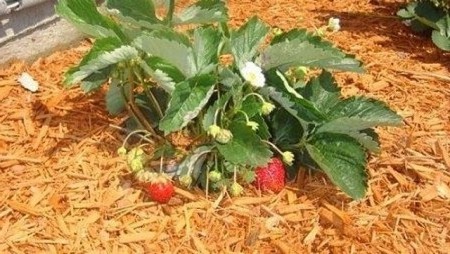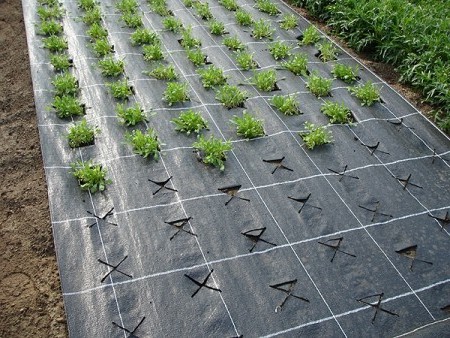Mulch will help gardeners reduce labor costs. Mulching raspberries, strawberries and other berries allows you to reduce the number of waterings and tillage, delays the evaporation of moisture from the soil, and protects it from crust formation and weed growth.
The bulk of raspberry and strawberry roots are located at a depth of 20-30 cm. To prevent this layer of soil from drying out in summer and freezing in winter, strawberry and raspberry plantings are mulched immediately after planting and in the first two years of life - in spring and autumn. When mulched, the soil cools down more slowly and does not overheat.
Mulch helps control weeds. Unlike weeding with a hoe, when the root system of cultivated plants is damaged, when mulching the roots are not damaged, and the yield of raspberries and strawberries increases.
When decomposed, mulch releases many nutrients needed by berry gardens and saturates the ground layer of air with carbon dioxide, which plants need for photosynthesis.
How to mulch the soil under raspberries and strawberries
The first mulching is carried out immediately after planting. For raspberries, the root zone 70-80 cm wide is covered with mulch. In the first 2-3 years of life, raspberry bushes are mulched with sawdust, sunflower, and buckwheat husks. The optimal layer of mulch for raspberries is at least 10 cm.
For strawberries, the entire row spacing is covered with mulch. Straw, sawdust, peat, humus, and crushed bark are suitable for mulching.
If you mulch berry bushes with sawdust, you will have to apply more nitrogen fertilizers, because during the process of rotting, sawdust takes nitrogen from the soil and can cause nitrogen starvation in strawberries and raspberries. Typically, the dose of ammonium nitrate when using sawdust is increased to 30-40 g per linear meter of row spacing.
Mulching the rows of strawberries after flowering with straw gives very good results - the berries will be clean and there will be no gray rot.
When mulching plantings annually, gardeners save water and effort in caring for berry fields, and create better conditions for the growth and development of bushes.
In the fall, plantings are also mulched.First they dig up the soil and water it, and then mulch it. With annual repetition of mulching of raspberry and strawberry bushes, the raspberries will form less shoots, and the strawberries will have much less rooted tendrils, that is, it will be easier to care for them and less fertilizer will be consumed.
Strawberries respond better than other crops to mulching the soil with humus or dark compost. At the same time, its roots do not freeze in winter and do not dry out in summer.
In summer, mulch protects strawberry roots from the heat, and the heart does not die (which happens when hilling with ordinary soil). When mulching plants, berries and foliage will not suffer from diseases, because... they will have no contact with the ground. Fern leaves protect strawberries from nematodes; they are good for mulching between rows.
There are often recommendations to mulch strawberries with pine needles - this is not correct! Needles can be used to mulch plants that like acidic soils, such as hydrangea. The needles acidify the soil and this mulching often causes the strawberries to turn yellow.
How to mulch gooseberries
For gooseberries, mulching the soil helps retain moisture and reduce the number of weeds under the bushes. You need to loosen the soil under the bushes shallowly - no more than 5-10 cm. Gooseberries love mulch made from humus or peat mixed with sifted ash (2 cups of ash per bucket of peat). Freshly cut grass is not suitable for it, because even in dry weather, gooseberries (some varieties) can be affected by powdery mildew.
Mulching currants
For currants, raspberries, and young fruit trees, it is better to use freshly cut, dried grass as mulch and not to dig up the ground either in spring or autumn. And in the fall, rake up all the mulch and burn it.Shallowly loosen the soil under these plants and cover the tree trunks with a layer of 5-8 cm of freshly cut grass. In winter, this layer will protect the roots from sudden temperature fluctuations if there is no snow. Pre-winter watering is carried out directly over the grass. In spring, this mulch retains moisture well.
In mid-April, before the currant buds open, all remaining mulch should be collected and burned. Loosen the soil under the berry fields and young trees shallowly, apply fertilizer if you did not apply it in the fall, and again cover all the soil under these plants with mown growing grass.
You can add new grass all summer. But before laying a new layer, you need to water the old layer with a urea solution (1 tablespoon per 10 liters of water), since rotting grass takes nitrogen from the soil, which plants need for growth. In the second half of summer, urea should not be added, as the plants are preparing for winter. Rotting grass at this time, taking nitrogen from the ground, stops the growth of shoots.
Mulching trees
In dry years, it is useful, especially on sandy soils, to mulch the soil under trees in the fall with humus and peat soil in a layer of 5-8 cm.
During dry summers and autumns, and when there is a danger of “black” frosts in young gardens, especially in gardens with dwarf fruit trees, mulching the tree trunks will help protect plants from stress.
The soil around young trees with a still shallow root system is mulched with the remains of grass after weeding, dried in the sun. Mowed lawn grass is also used.
After weeding the soil around the bushes, the seedless weeds are left in place as mulch. At the same time, using a hoe, they are lightly embedded shallowly into the soil (5 cm).
After planting, cherry and other fruit trees are watered and mulched with peat, compost or cut (withered) grass.




 CUCUMBERS NEVER GET SICK, I'VE BEEN USING ONLY THIS FOR 40 YEARS! I SHARE A SECRET WITH YOU, CUCUMBERS ARE LIKE THE PICTURE!
CUCUMBERS NEVER GET SICK, I'VE BEEN USING ONLY THIS FOR 40 YEARS! I SHARE A SECRET WITH YOU, CUCUMBERS ARE LIKE THE PICTURE! You can dig a bucket of potatoes from each bush. Do you think these are fairy tales? Watch the video
You can dig a bucket of potatoes from each bush. Do you think these are fairy tales? Watch the video
 How our fellow gardeners work in Korea. There is a lot to learn and just fun to watch.
How our fellow gardeners work in Korea. There is a lot to learn and just fun to watch. Eye trainer. The author claims that with daily viewing, vision is restored. They don't charge money for views.
Eye trainer. The author claims that with daily viewing, vision is restored. They don't charge money for views. A 3-ingredient cake recipe in 30 minutes is better than Napoleon. Simple and very tasty.
A 3-ingredient cake recipe in 30 minutes is better than Napoleon. Simple and very tasty. Therapeutic exercises for cervical osteochondrosis. A complete set of exercises.
Therapeutic exercises for cervical osteochondrosis. A complete set of exercises. Which indoor plants match your zodiac sign?
Which indoor plants match your zodiac sign? What about them? Excursion to German dachas.
What about them? Excursion to German dachas.